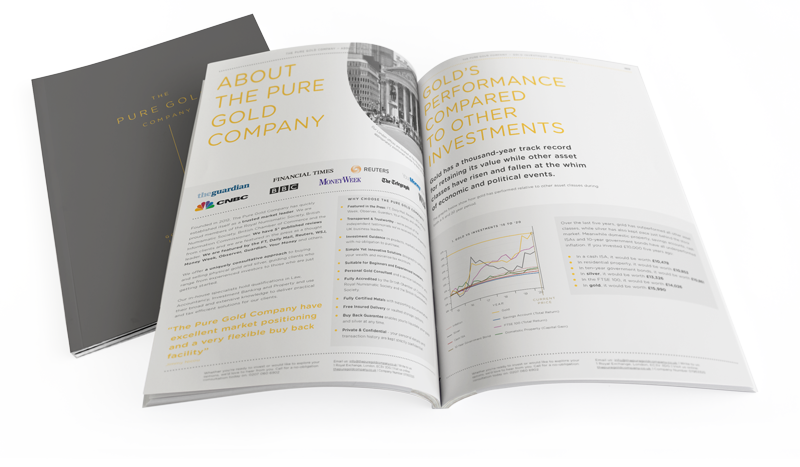How many carats are in pure gold?

Find out about the gold carat system, what ‘pure gold’ really means, and how to understand the difference between ‘carat’ and ‘karat’.
Pure gold is referred to as 24 carat, meaning all 24 parts are gold with minimal or no other metals mixed in. You might say pure gold contains all 24 carats, but as with most things in precious metals, the reality is a little more nuanced.
In this guide, we explain what a ‘carat’ is, how gold purity is measured, and why some ‘pure gold’ items are purer than others.
Carat vs. Karat: Understanding the Terminology
The word ‘carat’ can mean two different things, and that’s where confusion often arises:
- In the UK and most countries, ‘carat’ refers to both gold purity (e.g. 24 carat gold) and gemstone weight (e.g. a 1-carat diamond).
- In the US, the spelling ‘karat’ is used exclusively to describe gold purity, while ‘carat’ remains the term for gemstone weight.
So while 24 carat and 24 karat both mean the same thing, describing gold that’s at least 99.9% pure, the spelling depends on where you are.
The Gold Purity Scale Explained
Gold purity is measured using a 24-part scale. Here’s how it breaks down:
| Carat | Gold Content | Purity (%) |
| 24K | 24/24 parts | 99.9%+ |
| 22K | 22/24 parts | 91.7% |
| 18K | 18/24 parts | 75% |
| 14K | 14/24 parts | 58.3% |
| 9K | 9/24 parts | 37.5% |
24K is the highest purity level in the gold carat system, and what many brokers would consider pure gold. The idea of 24 parts in a gold standard has ancient roots. The Roman solidus weighed 24 siliquae, which influenced later medieval gold valuation systems — particularly in German-speaking regions, where the ‘mark’ was divided into 24 ‘karats’.
If a ‘gold’ item has a purity below 12K, less than half of it is made up of gold. This doesn’t always mean the item isn’t valuable, but if you’re investing in pure gold as a commodity 24K is truly the ‘gold standard’.
How to Tell the Purity of Gold
While a professional assayer provides the only certain evaluation, there are several ways to understand the purity of your gold.
Read the official Hallmark
Gold producers need to test the purity of their gold so that they can price it fairly. However, what matters most is the verdict of the relevant assay office. These institutions test gold items and imprint them with a hallmark (alternatively known as an ‘assay mark’) to confirm the gold content. In many cases, the assay office is also responsible for refining the gold and forming it into useful units such as gold bars.
Each assay house uses a set of hallmarks that denote different purity levels. The purity of 24K gold is certified on a hallmark with a fineness number, such as ‘999’ or ‘999.9’. The shape of the border around this number often denotes the metal type (an oval is common for gold), but this can vary by country.
A warning about ‘Home Tests’
While some ‘home tests’ are mentioned online, methods like using vinegar or a flame are highly unreliable and not recommended. They are not accurate for determining purity, can be fooled by quality gold plating, and can damage the item.
Professional Testing Methods
It’s also worth noting that these easy methods fall short when it comes to measuring the actual purity of gold. Processes such as cupellation (which involves melting down the gold) and X-ray fluorescence (XRF) testing are required to precisely assess gold content – and these methods obviously require specialist machinery and skills.
Can gold be purer than 24K?
The gold carat system would suggest that gold can’t be purer than 24K, as this designation applies to all gold items with a purity of 99.9% or higher.
However, some gold does have a higher purity than the average 24K bar or coin. This is best represented through the millesimal system, which assigns values of 999 to 99.9% pure gold (24K), and 999.9 to even finer gold with a purity of over 99.99%. (Higher purities are possible, but rarely produced.)
The question is: what does that extra 0.09% of purity achieve? Super-high-purity gold is perhaps desirable as a collector’s item or luxury curiosity, but for investment purposes, 24 carat is the norm.
Why Most gold items are not 24K
If you have an antique item that you’ve always considered to be ‘pure gold’, or you’ve bought a new item of gold jewellery, it might not actually be 24 carat.
24K gold does not have ideal properties for use in jewellery. Instead, jewellery-makers tend to use a gold alloy with a purity of up to 22K. This makes the item hard-wearing, as well as valuable.
A Note on Historical Gold Purity
Gold purity standards in the UK (and pre-union England) have changed over the centuries (and are not to be confused with the country’s historic financial gold standards, which fixed the price of gold until 1931). The first such standard, enacted by Edward I in the year 1300, ordered that gold money must be 24 carat, while gold wares (such as jewellery) had to be 19⅕K or purer. The required purity for gold coins fluctuated over the centuries, and was brought to a low point of 20K between 1545 and 1549. Jewellery sold in the UK today can be described as gold if it contains just 37.5% gold – making it 9 carat ‘yellow gold’.
So, while some antique gold coins were ‘pure gold’ in their day, and while gold jewellery may or may not have relatively high purity, these items might not meet the 24K standard.
In essence, the “hallmark” of a Royal Mint coin is the reputation and legal authority of the United Kingdom itself, making it one of the most trusted and secure forms of gold investment in the world.
- Sovereign Guarantee: The weight, dimensions, and purity of Britannia and Sovereign coins are mandated by UK law (The Coinage Act) and produced by The Royal Mint, an institution that is over 1,100 years old and operates on behalf of the government. Their authenticity is therefore guaranteed by the state itself.
- Legal Tender Status: These coins are official UK currency and have a nominal face value (e.g., £100 for a 1oz Britannia). This status as genuine currency, defined by law, makes the third-party verification of a hallmark unnecessary. The coin’s design, featuring the effigy of the monarch, is the ultimate stamp of approval.
Looking Into Gold Investment?
Book a FREE consultation with our expert brokers at The Pure Gold Company.

Understanding Gold Content: Investment Bars vs. Royal Mint Coins
When investing in physical gold, understanding the precise gold content and purity of your assets is essential. While both investment-grade bars and legal tender coins from The Royal Mint are highly valued for their gold, they adhere to different standards of purity and composition. A crucial distinction lies in hallmarking, which is a standard for bars but is not required for British investment coins for important legal reasons.
Investment-Grade Gold Bars: The Global Standard
Gold bars intended for investment are manufactured to meet globally recognised criteria, most notably the “Good Delivery” standards set by the London Bullion Market Association (LBMA). These standards ensure liquidity and trust in the international market.
- Purity and Fineness: To be considered investment-grade, a gold bar must have a minimum purity of 995 parts per thousand of fine gold, which is equivalent to 99.5% purity.
- The Modern Standard (999.9): While 99.5% is the minimum, the vast majority of gold bars produced for the modern investment market are refined to a purity of 999.9, meaning they are 99.99% pure gold. This is often referred to as “four nines” fineness and is the most common standard for new bars.
- Hallmarking is Essential: Every reputable investment gold bar is stamped with crucial information that serves as its guarantee of quality. This includes:
- The official stamp of the refiner (e.g., PAMP, Heraeus, Metalor).
- The bar’s weight (e.g., 1 oz, 100g).
- Its specific fineness (e.g., 999.9).
This hallmark confirms the bar’s authenticity and allows it to be traded with confidence worldwide.
Royal Mint Investment Coins: A Guarantee by Law
British legal tender bullion coins, such as the iconic Sovereign and Britannia, have their specifications set by law. Their status as official currency of the realm makes them unique and exempts them from the hallmarking process.
The Gold Sovereign
A cornerstone of British coinage for centuries, the Sovereign is renowned for its reliability and historical significance.
- Purity: 22 carat gold. This means it is 91.67% pure gold (a fineness of 916.7).
- Composition: The remaining 8.33% of the coin’s weight is an alloy, traditionally copper. This was designed to make the coin extremely durable and resistant to scratching when it was used in everyday circulation.
- Gold Content: Despite being 22 carat, the coin’s intrinsic value is determined by its pure gold content.
- Total Weight: 7.98 grams
- Fine Gold Weight: 7.32 grams (or 0.2354 troy ounces)
The Gold Britannia
As the United Kingdom’s flagship bullion coin, the Britannia is one of the most popular investment coins in the world.
- Purity (2013 onwards): Modern Gold Britannias (minted from 2013) are struck in 24 carat gold, with a fineness of 999.9 (99.99% pure). This change was made to align the coin with the global standard for one-ounce investment coins.
- Gold Content:
- Total Weight: 1 troy ounce (approximately 31.1 grams)
- Fine Gold Weight: 1 troy ounce
- Historical Purity (1987-2012): It is worth noting that earlier Britannias were made from 22 carat gold, like the Sovereign. However, they were made to a larger total weight to ensure they still contained exactly one troy ounce of pure gold.
Why Royal Mint Coins Do Not Have Hallmarks
This is a critical distinction for investors. The absence of a hallmark on a Britannia or Sovereign does not indicate a lack of authenticity; in fact, their credibility is guaranteed by a higher authority.
Under the UK Hallmarking Act 1973, articles of precious metal sold in the UK must be hallmarked by an independent assay office. However, the Act specifically exempts legal tender coins of the realm.
The Origins of Impurity: Why gold is Never 100% Pure
Gold, like all heavy elements, was formed in space during supernova explosions and neutron star collisions billions of years ago. It arrived on Earth via meteorite impacts and now exists in the Earth’s crust in natural deposits. Freshly mined gold is often impure because it mingles with other elements like silver and copper during its time underground.
It would be impossible to make gold artificially without using extremely expensive facilities such as a particle accelerator – and even if this were plausible, the amounts produced would be nanoscopic. So, we must make do with slight imperfections.
Gold is made practically pure through processing at a gold refinery. These facilities use methods including cupellation, electrolysis and chemical treatments to remove impurities.
There are technological and economic limits to gold refinement. A notable achievement in refining was made by the Perth Mint in 1957, which produced gold with a purity of 99.999%. Since then, other institutions like the Royal Canadian Mint have refined gold to even higher purities
Given that perfectly pure gold does not exist, the term ‘pure gold’ denotes an extremely low level of impurity, rather than absolute purity.
Gold purity FAQs
Q: How many carat is 100% pure gold?
100% pure gold does not exist, but 24K gold has the highest practical levels of purity (99.9% and higher).
Q2: What is the carat weight of pure gold?
A: The term ‘carat weight’ does not apply to gold; it’s a measure of the weight of gemstones such as diamonds. Pure gold has a carat purity of 24K. This is often described as the gold’s ‘carat’, which helps to prevent confusion between the two meanings of ‘carat’. The weight of gold items is usually measured in grams or ounces.
Q3: Is 22K or 18K considered pure?
22K or 18K is regarded as a high purity level in gold jewellery. In gold items intended for investment such as coins or bars, only a purity of 24K is considered truly pure.
Q4: What is the most pure gold carat available?
24 carat, which is often represented with a hallmark showing the number ‘999’ inside an oval. There is no special carat rating for extra-pure gold, which is sometimes indicated by a hallmark showing the number ‘999.9’.
Q5: What does 999 gold mean?
It means 99.9% pure gold, which is equivalent to 24K in the gold carat system.
Q6: What’s the difference between carat and carrot?
Carat (or karat in US English) refers to the purity of gold, based on a 24-part scale. Occasionally, people misspell it as carrot, especially in informal forums or online discussions. While the two words sound the same, only carat (or karat) is correct in the context of gold. Carrot refers to the orange root vegetable and has no connection to gold bullion or investment.
Q7 Why arent gold sovereigns 24 carat?
Gold sovereigns aren’t made from 24 carat gold because pure gold is too soft for coins that are meant to circulate or last a long time. Instead, sovereigns are struck in 22 carat gold (91.67% pure), which is mixed with a small amount of copper or other metals to make them harder and more durable. This blend helps the coin resist wear and damage while still retaining most of its gold value.
Historically, 22 carat gold—also known as “crown gold”—was chosen to ensure sovereigns could withstand handling without losing detail or integrity. It remains the standard today for both investment and collectable sovereign coins.

